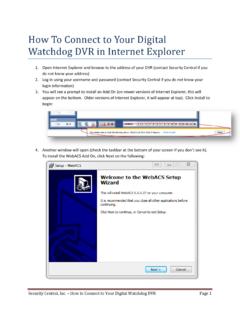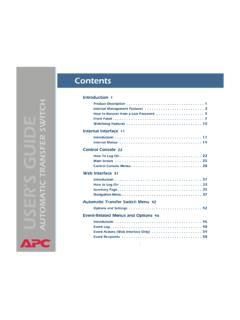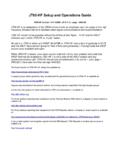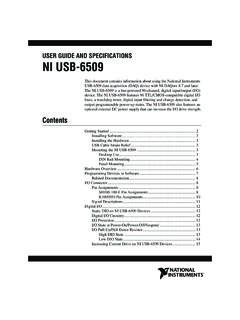Transcription of AN1278 APPLICATION NOTE - st.com
1 AN1278 /05021/44AN1278 APPLICATION NOTELIN (LOCAL INTERCONNECT NETWORK) SOLUTIONSby Microcontroller Division ApplicationsINTRODUCTIONMany mechanical components in the automotive sector have been replaced or are now beingreplaced by intelligent mechatronical systems. A lot of wires are needed to connect thesecomponents. To reduce the amount of wires and to handle communications between thesesystems, many car manufacturers have created different bus systems that are incompatiblewith each order to have a standard sub-bus, car manufacturers in Europe have formed a consortiumto define a new communications standard for the automotive sector.
2 The new bus, called LINbus, was invented to be used in simple switching applications like car seats, door locks, sunroofs, rain sensors, mirrors and so LIN bus is a sub-bus system based on a serial communications protocol. The bus is asingle master / multiple slave bus that uses a single wire to transmit data. To reduce costs, components can be driven without crystal or ceramic resonators. Time syn-chronization permits the correct transmission and reception of data. The system is based on aUART / SCI hardware interface that is common to most bus detects defective nodes in the network. Data checksum and parity check guaranteesafety and error a long-standing partner to the automotive industry, STMicroelectronics offers a completerange of LIN silicon products: slave and master LIN microcontrollers covering the protocolhandler part and LIN transceivers for the physical line interface.
3 For a quick start with LIN,STMicroelectronics supports you with LIN software enabling you to rapidly set up your first LINcommunication and focus on your specific APPLICATION 1. LIN Network OverviewMASTERSLAVESLAVESLAVELIN BusCAN Bus12/44 Table of Contents442 INTRODUCTION .. 11 LIN PROTOCOL .. 42 LIN PRODUCTS .. LIN MICROCONTROLLERS .. LIN Slave MCUs .. LIN Master MCUs .. LIN TRANSCEIVERS .. L9637 K-Line Transceiver .. L9638 LIN Transceiver .. 103 LIN SOFTWARE .. TYPES AND MACRO DEFINITIONS: .. Debug settings .. Types .. Macros .. PROTOCOL HANDLER: .. Type definition .. User interface functions.
4 Timeout handling .. Initializing the timer .. LIN CONFIGURATION FILE: .. APPLICATION INTERFACE: .. 204 EXAMPLES .. IMPLEMENTATION ON THE ST72254G2 - SOFTWARE EMULATED SCI .. Step by Step Configuration .. IMPLEMENTATION ON THE ST72334N4 - HARDWARE SCI .. Step by Step Configuration .. Master data request (DataRequest_Notification) .. Data reception (DataReceived_Notification) .. STMICROELECTRONICS LIN PACKAGE - EXAMPLE INSTALLATION .. LIN package .. Quick start with STVD7 and Cosmic C Compiler .. PERFORMANCE .. Timing considerations .. Using the Emulated SCI.
5 Reception .. Transmission .. 403/44 Table of Using the on-chip SCI .. Reception .. Transmission .. 435 SUMMARY OF CHANGES .. 4314/44 LIN (LOCAL INTERCONNECT NETWORK) SOLUTIONS1 LIN PROTOCOLThe aim of this chapter is to give an overview of the LIN protocol and concept. For detailed andup-to-date information please refer to the official LIN homepage: whereyou can register for the LIN specification LIN specification package consists of three parts:nThe LIN protocol specificationnThe LIN configuration language descriptionnThe LIN APIThe first part describes the LIN physical and data link layers. The second part describes theLIN configuration language.
6 The LIN configuration language enables the user LIN network tobe described in a file (how many nodes, how many frames, frame description, baudrate etc.).The goal of this specification is to ease communications between the parties involved in thedevelopment of a LIN network like car manufacturers and their suppliers. The third and lastpart is about the software implementation of the LIN protocol and specifies some points onhow the software implementation has to be LIN concept uses a single master / multiple slave model. Only the master is able to initiatea communication. A LIN frame consists of a header and a response part. To initiate a commu-nication with a slave the master sends the header part.
7 If the master wants to send data to theslave it goes on sending the response part. If the master requests data from the slave theslave sends the response 2. Basics of LIN communicationDirect communication between slaves is not possible. But as all nodes always listen to thebus, a master request can be used to handle slave-to-slave 1 Slave 2 HeaderResponse1 LIN framesent by:MasterSlave 1 Slave 2 Master to slave 1 Slave 2 to masterLINBus5/44 LIN (LOCAL INTERCONNECT NETWORK) SOLUTIONSThe LIN protocol is object-oriented and not address-oriented. The header contains the identi-fier which identifies the LIN frame and the data it contains.
8 Different nodes may receive thesame frame response part consists mainly of data of selectable length (1 to 8 bytes). The data are se-cured by an 8 bit LIN protocol is time-trigger oriented. The master periodically sends the same sequence ofLIN frames. Each sequence, the master and the slaves update the data they send and re-ceive. The sequence sent by the master may change depending on APPLICATION : The slave is a sensor measuring a analog value which is communicated to themaster via LIN. The slave continuously measures its analog input independently from the LINcommunication. In response to a master request (periodical) the slave sends the up-to-date/last measured value of the analog 3.
9 Time-triggered protocolIn order to achieve a good level of security, different mechanisms exist like parity bits on theidentifier or checksum on data important feature of the protocol is to enable the slave MCUs to run with low cost oscilla-tors such as an integrated RC oscillator provided that the accuracy is better than +/-15%. Forthis purpose the header contains a sync field byte consisting of the constant 0x55. This byteenables each slave to measure the master bit time and to synchronize its clock order to obtain very low power consumption, the master is able to send a sleep frame. Anynode can go into low power mode. To wake up the network, any node can send a so-calledwake-up 1 Slave 21 sequenceAnalog value:25 AnalogchangevalueAnalog value:3825253838 LINBus6/44 LIN (LOCAL INTERCONNECT NETWORK) SOLUTIONSF igure 4.
10 Sleep mode - wake-upSleep modecommandWake-upsignal normal modeSleep modeNetworkstart-up normal mode7/44 LIN (LOCAL INTERCONNECT NETWORK) SOLUTIONS2 LIN PRODUCTSA typical LIN node consists of a microcontroller for handling the LIN protocol and a LIN trans-ceiver for interfacing the digital part and the physical line (see Figure 5 . LIN bus topology).STMicroelectronics offers both kind of 5. LIN bus LIN MICROCONTROLLERSSTM icroelectronics offers a wide range of microcontrollers suitable for master and/or LIN Slave MCUsTable 1. Very low cost LIN slave MCUs - full software solution - Flash/ROM MCUsFeaturesST72104G1 ST72104G2 ST72216G1 ST72215G2 ST72254G1 ST72254G2 Program memory - bytes4k8k4k8k4k8kRAM (stack) - bytes256 (128)PeripheralsWatchdog timer, One 16-bit timer, SPIW atchdog timer, One 16-bit timer, SPI, ADCW atchdog timer, Two16-bit timers, SPI, ADCW atchdog timer, Two 16-bit timers, SPI, I2C, ADCO perating to FrequencyUp to 8 MHz (with oscillator up to 16 MHz)Operating Tempera-ture-40 C to +85 C (-40 C to +105/125 C optional)















